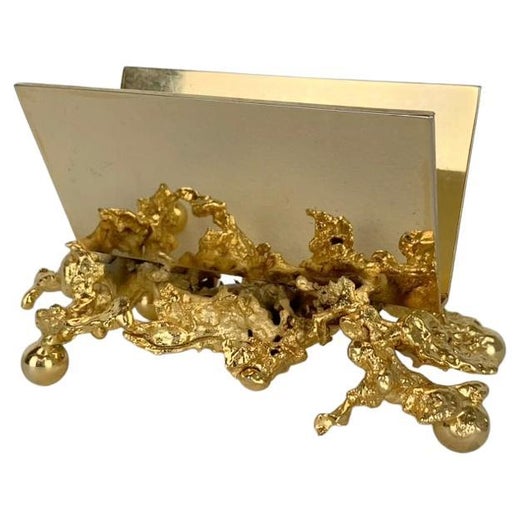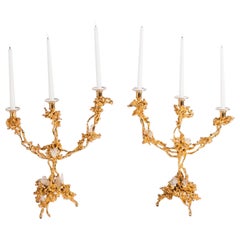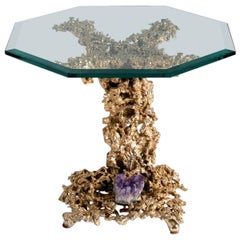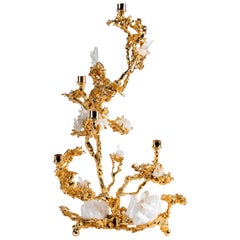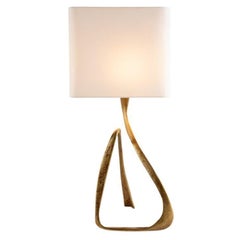Claude Boeltz, Bronze Eclaté Table Lamp, France, circa 1970
About the Item
- Creator:Claude Victor Boeltz (Artist)
- Dimensions:Height: 26.75 in (67.95 cm)Width: 15.75 in (40.01 cm)Depth: 9.5 in (24.13 cm)
- Materials and Techniques:
- Place of Origin:
- Period:
- Date of Manufacture:1970
- Condition:
- Seller Location:New York, NY
- Reference Number:Seller: BOELC 011stDibs: LU781320104872
Claude Victor Boeltz
Each Claude Victor Boeltz piece is glamorous yet retains a richly organic feel that adds a touch of bold sophistication to any interior. This French Surrealist designer popularized a technique he called “exploded bronze” — a process that has the metal components of a given piece appear as if they were liquified and then crystalized after an explosion.
Boeltz was born in Paris in 1937. There were several artists in his family, and Boeltz quickly developed creative interests at an early age. He fell in love with painting, architecture, ceramics and more, but was also intrigued by scientific fields such as geology and anatomy.
Boeltz studied under the sculptor Henri Molins and apprenticed at the Susse Frères and Houdot foundries. Additionally, he enrolled in classes in the evenings at the Boulle School in Paris and the Paris Academy of Art. He frequented museums and found much to appreciate in the work of artists such as Alberto Giacometti, Demetre Chiparus, Salvador Dalí, and Émile-Jacques Ruhlmann.
After moving to the French Riviera, Boeltz became personally acquainted with Pablo Picasso. He worked for a period with Picasso, and in the mid-1960s, he established a foundry in the Loire Valley. By the late 1960s, his work was being noticed around Europe (his works were sold by the likes of Cartier). His turning point came in the early 1970s when he met the sculptor César Baldaccini, whose “compression” pieces inspired Boeltz to experiment with abandon, and his “exploded bronze” technique was born.
Boeltz’s Hollywood Regency-style furnishings — mirrors, candlesticks, picture frames, lamps and even ceiling fixtures — were made with this new process. The designer then worked to decorate these “exploded” pieces with semi-precious stones — often African emeralds — or other luminous materials such as quartz and Murano glass. He subsequently opened two foundries to produce these kinds of works.
In the early 1980s, Boeltz moved his facilities to the United States. He built a large foundry in Nevada, and today, Las Vegas hotels now house many of his works. His collectors have also included Salvador Dalí, Baron Rothschild and others.
On 1stDibs, find Claude Victor Boeltz decorative items, lighting, serveware and more.
You May Also Like
Vintage 1970s French Table Lamps
Bronze
Vintage 1970s French Brutalist Table Lamps
Agate, Rock Crystal, Brass, Bronze
Vintage 1980s French Table Lamps
Rock Crystal, Gold, Bronze
Vintage 1980s French Post-Modern Table Lamps
Rock Crystal, Gold, Brass, Bronze
20th Century French Mid-Century Modern Table Lamps
Rock Crystal, Gold, Bronze
Mid-20th Century French Brutalist Table Lamps
Bronze
Vintage 1970s French Hollywood Regency Picture Frames
Stone, Quartz, Bronze
Vintage 1980s French Hollywood Regency Table Lamps
Rock Crystal, Gold Plate, Bronze
Vintage 1980s French Hollywood Regency Table Lamps
Rock Crystal, Gold Plate, Bronze
Mid-20th Century French Brutalist Picture Frames
Bronze
More From This Seller
View AllVintage 1970s French Candelabras
Quartz, Bronze
Late 20th Century French Coffee and Cocktail Tables
Amethyst, Bronze
2010s American Candelabras
Quartz, Bronze
2010s French Table Lamps
Bronze
2010s French Table Lamps
Bronze
Vintage 1930s French Art Deco Table Lamps
Bronze
Recently Viewed
View AllRead More
Who Were Guillerme et Chambron? French Veterans of WWII with a Knack for Clever, Quirky and Livable Furniture
Their charming solid-oak pieces offer homes utility and comfort.
Sit on a Cactus? If It’s Georgis & Mirgorodsky’s Le Nopal Chair, the Answer Is Yes, Please!
The witty piece was inspired by Surrealism and vaquero culture.
